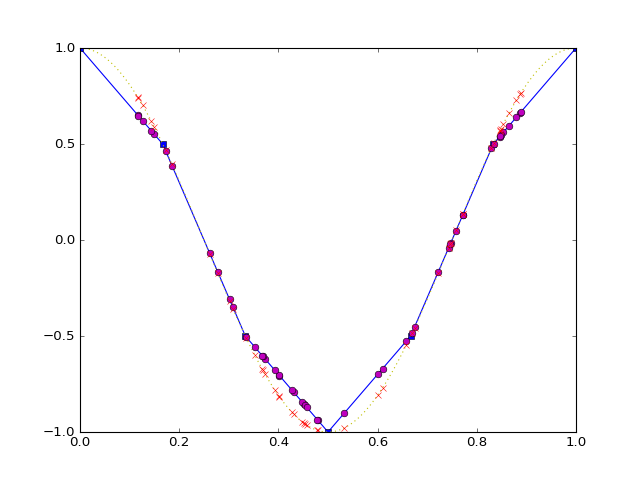Matrix Utilities¶
-
matrixutils.matutils.mkvc(x, numDims=1)[source]¶ Creates a vector with the number of dimension specified
e.g.:
a = np.array([1, 2, 3]) mkvc(a, 1).shape > (3, ) mkvc(a, 2).shape > (3, 1) mkvc(a, 3).shape > (3, 1, 1)
-
matrixutils.matutils.ndgrid(*args, **kwargs)[source]¶ Form tensorial grid for 1, 2, or 3 dimensions.
Returns as column vectors by default.
To return as matrix input:
ndgrid(…, vector=False)The inputs can be a list or separate arguments.
e.g.:
a = np.array([1, 2, 3]) b = np.array([1, 2]) XY = ndgrid(a, b) > [[1 1] [2 1] [3 1] [1 2] [2 2] [3 2]] X, Y = ndgrid(a, b, vector=False) > X = [[1 1] [2 2] [3 3]] > Y = [[1 2] [1 2] [1 2]]
-
matrixutils.matutils.ind2sub(shape, inds)[source]¶ From the given shape, returns the subscripts of the given index
-
matrixutils.matutils.sub2ind(shape, subs)[source]¶ From the given shape, returns the index of the given subscript
-
matrixutils.matutils.inv3X3BlockDiagonal(a11, a12, a13, a21, a22, a23, a31, a32, a33, returnMatrix=True)[source]¶ B = inv3X3BlockDiagonal(a11, a12, a13, a21, a22, a23, a31, a32, a33)
inverts a stack of 3x3 matrices
- Input:
- A - a11, a12, a13, a21, a22, a23, a31, a32, a33
- Output:
- B - inverse
Curv Utilities¶
-
matrixutils.curvutils.volTetra(xyz, A, B, C, D)[source]¶ Returns the volume for tetrahedras volume specified by the indexes A to D.
Parameters: - xyz (numpy.ndarray) – X,Y,Z vertex vector
- A,B,C,D (numpy.ndarray) – vert index of the tetrahedra
Return type: Returns: V, volume of the tetrahedra
Algorithm https://en.wikipedia.org/wiki/Tetrahedron#Volume
\[ \begin{align}\begin{aligned}V = {1 \over 3} A h\\V = {1 \over 6} | ( a - d ) \cdot ( ( b - d ) ( c - d ) ) |\end{aligned}\end{align} \]
-
matrixutils.curvutils.indexCube(nodes, gridSize, n=None)[source]¶ Returns the index of nodes on the mesh.
- Input:
- nodes - string of which nodes to return. e.g. ‘ABCD’ gridSize - size of the nodal grid n - number of nodes each i,j,k direction: [ni,nj,nk]
- Output:
- index - index in the order asked e.g. ‘ABCD’ –> (A,B,C,D)
TWO DIMENSIONS:
node(i,j) node(i,j+1) A -------------- B | | | cell(i,j) | | I | | | D -------------- C node(i+1,j) node(i+1,j+1)
THREE DIMENSIONS:
node(i,j,k+1) node(i,j+1,k+1) E --------------- F /| / | / | / | / | / | node(i,j,k) node(i,j+1,k) A -------------- B | | H ----------|---- G | /cell(i,j) | / | / I | / | / | / D -------------- C node(i+1,j,k) node(i+1,j+1,k)
-
matrixutils.curvutils.faceInfo(xyz, A, B, C, D, average=True, normalizeNormals=True)[source]¶ function [N] = faceInfo(y,A,B,C,D)
Returns the averaged normal, area, and edge lengths for a given set of faces.
If average option is FALSE then N is a cell array {nA,nB,nC,nD}
- Input:
- xyz - X,Y,Z vertex vector A,B,C,D - vert index of the face (counter clockwize)
- Options:
- average - [true]/false, toggles returning all normals or the average
- Output:
- N - average face normal or {nA,nB,nC,nD} if average = false area - average face area edgeLengths - exact edge Lengths, 4 column vector [AB, BC, CD, DA]
see also testFaceNormal testFaceArea
@author Rowan Cockett
Last modified on: 2013/07/26
Mesh Utilities¶
-
matrixutils.meshutils.meshTensor(value)[source]¶ meshTensor takes a list of numbers and tuples that have the form:
mT = [ float, (cellSize, numCell), (cellSize, numCell, factor) ]
For example, a time domain mesh code needs many time steps at one time:
[(1e-5, 30), (1e-4, 30), 1e-3]
Means take 30 steps at 1e-5 and then 30 more at 1e-4, and then one step of 1e-3.
Tensor meshes can also be created by increase factors:
[(10.0, 5, -1.3), (10.0, 50), (10.0, 5, 1.3)]
When there is a third number in the tuple, it refers to the increase factor, if this number is negative this section of the tensor is flipped right-to-left.
Interpolation Utilities¶
-
matrixutils.interputils.interpmat(locs, x, y=None, z=None)[source]¶ Local interpolation computed for each receiver point in turn
Parameters: - loc (numpy.ndarray) – Location of points to interpolate to
- x (numpy.ndarray) – Tensor of 1st dimension of grid.
- y (numpy.ndarray) – Tensor of 2nd dimension of grid. None by default.
- z (numpy.ndarray) – Tensor of 3rd dimension of grid. None by default.
Return type: Returns: Interpolation matrix
(Source code, png, hires.png, pdf)
